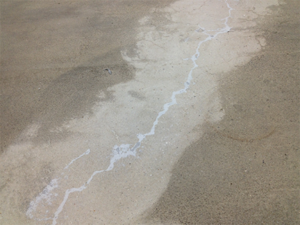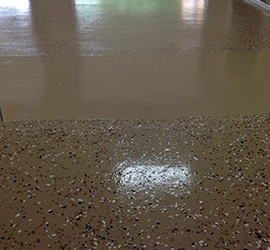Multi-Color Epoxy Flooring DIY
HOW TO DO A MULTI-COLOR EPOXY FLOOR
 Girvan P. wanted a two color floor with a border. This is how he did it. Once the floor is properly prepped by etch acid etching or grinding and or both. You apply the first base coat. In Girvan’s case he wanted a solid color so we went with our Armor II commercial system. So he did the whole floor in Light Gray and then when that dried the next day he taped off the rectangles and applied the Dark Gray epoxy inside the tape lines. He let that dry and he then taped off the border area and lightly sanded the epoxy floor border area inside the taped area. This was because the base coat had now been curing for more than 24 hours. Anytime an epoxy coating cures for more than 24 hours you want to lightly sand it to give the epoxy coating going over it a rough surface to adhere too. So once the border area was sanded he applied the Yellow epoxy coat.
Girvan P. wanted a two color floor with a border. This is how he did it. Once the floor is properly prepped by etch acid etching or grinding and or both. You apply the first base coat. In Girvan’s case he wanted a solid color so we went with our Armor II commercial system. So he did the whole floor in Light Gray and then when that dried the next day he taped off the rectangles and applied the Dark Gray epoxy inside the tape lines. He let that dry and he then taped off the border area and lightly sanded the epoxy floor border area inside the taped area. This was because the base coat had now been curing for more than 24 hours. Anytime an epoxy coating cures for more than 24 hours you want to lightly sand it to give the epoxy coating going over it a rough surface to adhere too. So once the border area was sanded he applied the Yellow epoxy coat.
Now he sanded the entire floor with a block & pole sander using 100 grit paper. Got off all the dust and sanding residue and applied a clear topcoat over the entire floor. He now has a beautiful two color epoxy floor with high performance commercial coating that will last many years to come.
It’s easier than it sounds to do these types of floors and you can use any colors or as many colors as you like. We at ArmorGarage can help you layout your floor and guide you on the best way to do it. Like we did with Girvan. Here’s what Girvan had to say in an email to us.
“Hi Jim –
New garage floor successfully installed (see pic)- it looks fabulous! This despite the onset of winter – we managed to keep the heat up sufficiently. Quantities were just right – half a can of clear coat left for touch ups.
Very many thanks for all your help
Girvan P.
Ottawa, Canada”


 Once the floor is properly prepared (see how to
Once the floor is properly prepared (see how to